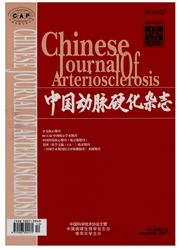

 中文摘要:
中文摘要:
目的探讨非糖尿病合并冠心病患者血浆骨桥蛋白水平与冠状动脉严重程度的相关性。方法入选166例因稳定型心绞痛入院的非糖尿病患者,采集一般临床资料和常规化验指标结果,通过酶联免疫吸附试验检测外周血骨桥蛋白水平。行冠状动脉造影明确冠心病,按照冠状动脉病变血管数进行严重程度分组:无冠状动脉病变组、单支冠状动脉病变组、双支冠状动脉病变组、三支冠状动脉病变组。冠状动脉钙化积分通过64排螺旋CT扫描机测定。按冠状动脉钙化积分分组:无钙化组(〈10)、轻度钙化组(11~100)、中度钙化组(101~400)和重度钙化组(〉400)。结果随着冠状动脉狭窄程度和钙化程度的加重,血浆骨桥蛋白水平呈升高趋势。血浆骨桥蛋白水平与非糖尿病合并冠心病患者冠状动脉狭窄严重程度(r=0.50,P〈0.01)及冠状动脉钙化积分呈正相关(r=0.38,P〈0.01)。结论血浆骨桥蛋白水平可能是非糖尿病合并冠心病患者冠状动脉狭窄及钙化程度的独立危险因素。
 英文摘要:
英文摘要:
Aim To seek the association between plasma osteopontin( OPN) levels and severity of coronary heart disease in non-diabetic subjects. Methods A total of 166 stable angina patients free of diabetes were enrolled in the study. Clinical characteristic of patients was recorded. Plasma OPN levels were measured by an enzyme-linked immunosorbent assay method. Coronary heart disease was determined by coronary artery angiography. The extent of coronary artery stenosis was represented as the numbers of 50% stenotic vessels. Coronary artery clacification was evaluated by 64slice spiral CT. The coronary artery clacification scores were classified into 4 categories on the basis of their severity: no calcification( ≤10),mild calcification( 11 ~ 100),moderate( 101 ~ 400),severe( 400). Results As the severity of coronary artery calcification and coronary stenosis,plasma OPN levels were increased. Plasma OPN levels were positively associated with coronary artery calcification and coronary stenosis. Conclusion Plasma OPN levels can be considered as an independent factor of coronary artery calcification and coronary stenosis in coronary heart disease patient without diabetes.
 同期刊论文项目
同期刊论文项目
 同项目期刊论文
同项目期刊论文
 Biodistribution and Elimination Study of Fluorine-18 Labeled N-epsilon-Carboxymethyl-Lysine followin
Biodistribution and Elimination Study of Fluorine-18 Labeled N-epsilon-Carboxymethyl-Lysine followin 期刊信息
期刊信息
